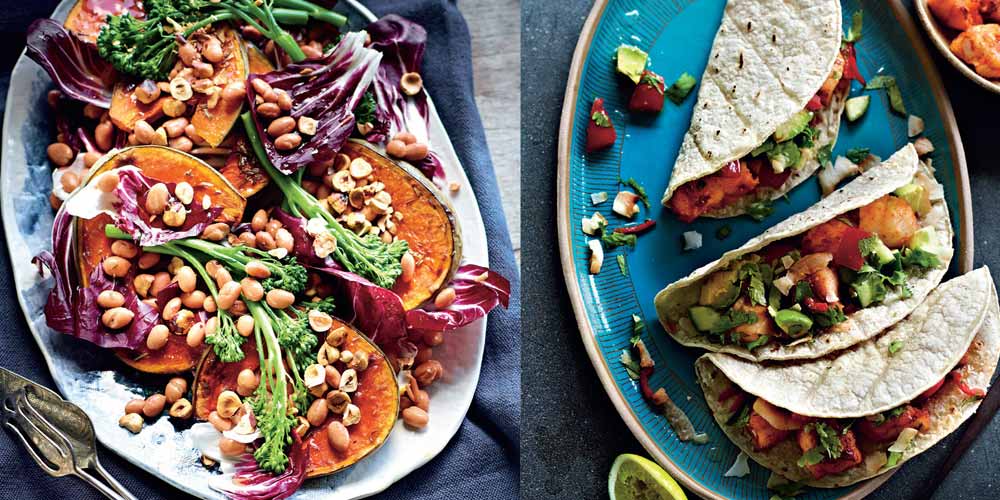A useful source of new ideas for boosting your intake of whole foods with an emphasis on healthy choices.
It only takes a quick internet search to discover that inflammation (and how to reduce it) is a hot topic in the health and wellness world. There are research studies, lifestyle overhauls and more cookbooks than you can poke a carrot stick at. While many of the more extravagant claims about the miracle powers of ‘superfoods’ lack the backing of credible science, there’s strong support for a Mediterranean-style diet that limits the intake of processed foods. Increasing our intake of vegetables, fruit, legumes, seafood, wholegrains, nuts, seeds and oils has proven benefits.
Australian nutritionist and health author Chrissy Freer is a member of the Nutrition Society of Australia and has contributed to a range of publications (including delicious magazine and taste.com.au) as a nutrition writer, recipe developer, food editor and stylist. In her latest cookbook, Freer takes a balanced approach to planning healthy meals with the aim of boosting immunity and reducing the risk of chronic inflammation.
The Anti-Inflammatory Cookbook features 100 simple, appealing recipes and a two-week meal plan. All meals are gluten free. The 240-page paperback begins with an introduction explaining inflammation in simple terms and a general outline of foods to embrace or avoid. Each dish is accompanied by a colour photo and a brief note highlighting the beneficial qualities of the ingredients. Cooking steps are described clearly and often include serving tips and advice on substitutions. Many of the meals are vegetarian or vegan, dairy- and nut-free. Freer has included recipes for breakfast, snacks, salads, soups and curries, as well as separate sections for poultry, seafood, meats and vegetables. She covers pantry basics, and there’s an index listing ingredients as well as recipe names. It’s a well-laid-out, easy-to-use book that shows how easy it is to make healthier choices throughout the day.
Strawberry, Chia and Ginger Jam (page 28)

Requiring only six ingredients and one saucepan, this recipe is a breeze and could be attempted by people of all cooking abilities. The steps are simple—first, simmer strawberries, honey, ginger, lemon juice and vanilla, then stir in some chia seeds before pouring the hot liquid jam into a sterilised jar. Fresh or frozen strawberries can be used (I opted for frozen), and Freer suggests raspberries, blueberries or blackberries would work just as well. I decided to double the cooking time as the mixture seemed overly runny, and I was worried that the small amount of chia wouldn’t be enough to thicken the jam sufficiently. What I ended up with was a fresh, fruity spread that was very light in both flavour and texture—pleasant but not gutsy enough for my dark rye toast. I’ve frozen the remainder of the jam and will experiment with using it as a topping for things like yoghurt and muesli.
Japanese Pancakes with Mushrooms and Chicken (page 117)

This was my favourite of the three recipes I tried, as it delivered a quick, tasty meal with endless possible variations. It doesn’t require much more than some chopping and frying—ideal for a midweek dinner when you don’t want to spend too much time in the kitchen. I followed Freer’s ingredient suggestions, although I did use olive oil in place of macadamia oil. The combination of chicken, mushroom and savoy cabbage with fresh ginger and garlic worked really well, but you could use whatever takes your fancy (or whatever you have in the fridge!). I chose to wilt the finely shredded cabbage in the frying pan with the chicken and mushroom before adding it to the pancake batter, rather than adding it raw, and I was pleased with the result.
Double Choc Bean Brownies (page 208)

These were a winner. While lighter in texture and intensity to the brownies I’ve made in the past, these bean-based chocolate treats were delicious (and were snapped up quickly when I shared them at a family barbecue). The recipe called for canned adzuki beans but I chose to use red kidney beans instead. Black beans would also work as a substitute. The recipe steps (melting chocolate, blitzing beans and eggs in a food processor, combining ingredients and then baking) are easy for competent home cooks. The delicacy of the end result calls for a careful approach when it comes to removing the baked brownie cake from the tin, and I recommend letting it rest for quite a while before cutting into squares.
Reviewed by Jo Vabolis
Twitter: @JoVabolis
Distributed by: Murdoch Books
Released: September 2019
RRP: $35























